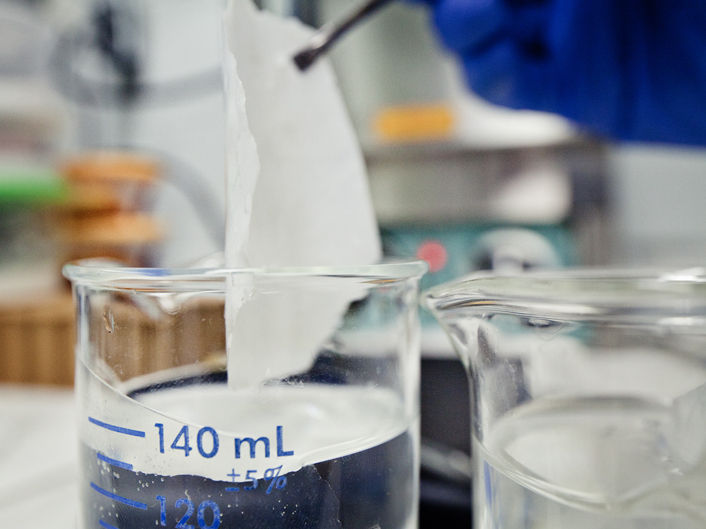How new materials increase the efficiency of direct ethanol fuel cells
Composite membrane consists of Nafion with embedded nanoparticles
A group from Brazil and an HZB team have investigated a novel composite membrane for ethanol fuel cells. It consists of the polymer Nafion, in which nanoparticles of a titanium compound are embedded by the rarely explored melt extrusion process. At BESSY II they were able to observe in detail, how the nanoparticles in the Nafion matrix are distributed and how they contribute to increase proton conductivity.

The material consists of Nafion with embedded nanoparticles.
© B.Matos/IPEN
Ethanol has five times higher volumetric energy density (6.7 kWh/L) than hydrogen (1.3 kWh/L) and can be used safely in fuel cells for power generation. In Brazil in particular there is great interest in better fuel cells for ethanol as all the country distributes low-cost ethanol produced in a renewable way from sugar cane. Theoretically, the efficiency of an ethanol fuel cell should be 96 percent, but in practice at the highest power density it is only 30 percent, due to a variety of reasons. So there is great room for improvements.
Nafion with nanoparticles
A team led by Dr. Bruno Matos from the Brazilian research institute IPEN is therefore investigating novel composite membranes for direct ethanol fuel cells. A promising solution is tailoring new polymer-based composite electrolyte materials to replace the state-of-the-art polymer electrolyte such as Nafion. Matos and his team use melt extrusion process to produce composite membranes based on Nafion with additional titanate nanoparticles, which have been functionalized with sulfonic acid groups.
Infrared experiments at BESSY II
Matos' team has now thoroughly analysed four different compositions of Nafion composite membranes at the infrared beamline IRIS at BESSY II. Small-angle X-ray scattering measurements confirmed that the titanium particles were synergistically interacting with the ionomer matrix of Nafion.
Proton conductivity increased
Using infrared spectroscopy, they observed that chemical bridges were formed between the sulfonic acid groups of the functionalized nanoparticles. In addition, by following the proton motion along the ionic clusters, they found increased proton conductivity in the composite membrane, even at high concentrations of nanoparticles. "This was a real surprise that we didn't expect," Dr. Ljiljana Puskar, HZB-scientist at the IRIS-Beamline says. The reduction of the conductivity with the increment of the nanoparticles is one of the main hurdles delaying the development of high-performance composite materials. The higher proton conductivity could allow better charge carrier mobility and thus increase the efficiency of the direct ethanol fuel cell.
Advantage of melt extrusion
"This composite membrane can be produced by melt extrusion, which would allow their production on industrial scale," Matos points out.
Original publication
Most read news
Original publication
B.R. Matos, C.A. Goulart, B. Tosco, J.S. da Silva, R.A. Isidoro, E.I. Santiago, M. Linardi, U. Schade, L. Puskar, F.C. Fonseca, A.C. Tavares; "Properties and DEFC tests of Nafion - Functionalized titanate nanotubes composite membranes prepared by melt-extrusion"; Journal of Membrane Science; 2020
Topics
Organizations
Other news from the department science
These products might interest you

NANOPHOX CS by Sympatec
Particle size analysis in the nano range: Analyzing high concentrations with ease
Reliable results without time-consuming sample preparation

Eclipse by Wyatt Technology
FFF-MALS system for separation and characterization of macromolecules and nanoparticles
The latest and most innovative FFF system designed for highest usability, robustness and data quality

DynaPro Plate Reader III by Wyatt Technology
Screening of biopharmaceuticals and proteins with high-throughput dynamic light scattering (DLS)
Efficiently characterize your sample quality and stability from lead discovery to quality control

Get the chemical industry in your inbox
By submitting this form you agree that LUMITOS AG will send you the newsletter(s) selected above by email. Your data will not be passed on to third parties. Your data will be stored and processed in accordance with our data protection regulations. LUMITOS may contact you by email for the purpose of advertising or market and opinion surveys. You can revoke your consent at any time without giving reasons to LUMITOS AG, Ernst-Augustin-Str. 2, 12489 Berlin, Germany or by e-mail at revoke@lumitos.com with effect for the future. In addition, each email contains a link to unsubscribe from the corresponding newsletter.



























































